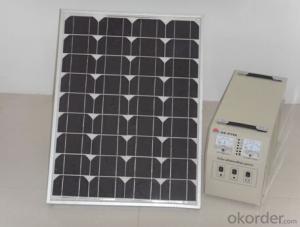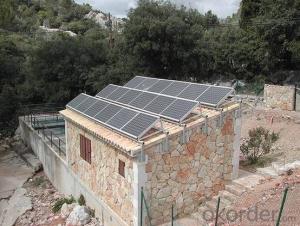CNBM Solar Home System Roof System Capacity-80W
- Loading Port:
- Shanghai
- Payment Terms:
- TT or LC
- Min Order Qty:
- 10 PCS
- Supply Capability:
- 500000 PCS/month
OKorder Service Pledge
OKorder Financial Service
You Might Also Like
Introduction of Solar Home System
Solar Home System is composed by Solar Panels, Inverters, Charger Controller, Battery, Cable, Mounting Bracket, which is applied to produce electricity for home use.
Solar Home System is quite suitable product in urban area and the place which is short of electricity. As the cost of solar products reduced, more and more family can bear the charge of solar products. These products apply to schools, hospitals, public halls and private housing, communication stations, weather station. Also can use as household appliances, lighting, communications equipment, meteorological equipment.
Our company’s main target is to make every family can use cheap solar energy and enjoy the new innovation of modern science and technology.
Picture of Our Factory

Working Principle of Solar Home System
This is an off-grid solar system which uses batteries to store the solar energy, at the same time, the solar system can be connected with the grid for utilization of grid power. The solar system uses battery power in priority, but when sunshine is not so good or loads consumption is too big which caused the battery power inadequacy, then the system can switch automatically to grid power supply. Meanwhile, the system can charge the batteries with grid power until batteries are fully charged. Then the solar system will switch back to battery power supply.
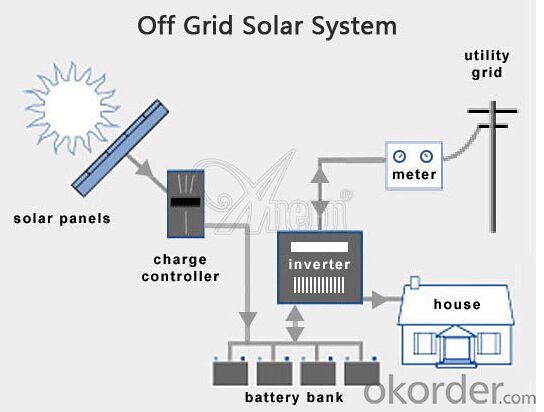
Product Details of Solar Home System
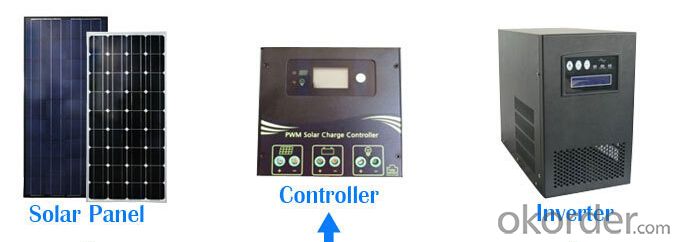
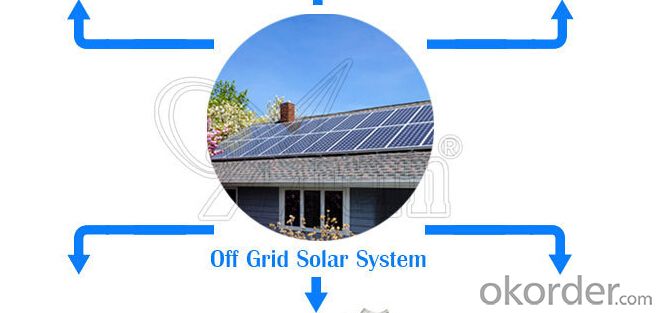

Specification of Solar Home System
Technical data: | |||||||||
Inverter | Rated load power | 500W | |||||||
Output wave | Pure sine wave | ||||||||
Input voltage | 24V | ||||||||
Output voltage | DC:12V | ||||||||
Output frequency | 50HZ/60HZ | ||||||||
Precision of output frequency | ±6% | ||||||||
Solar panel | Pmax | 100W*2PCS | |||||||
Vmp | 36V | ||||||||
Imp | 5.56A | ||||||||
Charger | Charger voltage & current | 24V10A | |||||||
Battery | Capacity | 12V80AH*2PCS | |||||||
Power box | Spray paint iron box,with input,output, ammeter,voltmeter,master switch and so on. | ||||||||
Package data: | |||||||||
Part | Size (L*W*H mm) | Weight (kg) | 20' (pcs) | 40' (pcs) | |||||
Power box | 580*520*540 | 60 | 96Sets | 240Sets | |||||
Solar panel | 1240*570*90 | 20 | |||||||
Solar panel bracket |
|
| |||||||
Loading electrical equipment(For consulting) | |||||||||
Name of Load | Power(W) | Quantity | Working Time per Day (H) | Working Days | |||||
Color TV | 65W | 1 | 4 | 3 days | |||||
Satellite TV Receivers | 25W | 1 | 4 | 3 days | |||||
lamp | 11W | 2 | 8 | 3 days | |||||
Other | 150W |
| 1 | 3 days | |||||
Advantage of Our Solar Home System
1 Excellent Performance: Our Solar Home System is composed by Brand Standard Kits with high quality. Our solar system has the advantage of high efficiency and stable operation. We can ensure our product with a long life period.
2. Small Orders Accepted: We can accept small orders as our customer’s trial order.
3. Guarantee/Warranty: We supply 10 Years Product Warranty and 25 Years Performance warranty.
4. Warehouse: We have warehouse overseas which can bring great convenience to our customer to pick up the products.
FAQ
Q: You are a manufacturer or Trader?
A: We are a Group corp. with 1GW capacity, which is Okorder’s registered VIP Supplier, enjoy Okorder’s Financial Guarantee.
Q: Required mainly certificates (CE&IEC/TUV/RoHS)?
A: Our products are certificated by CE RoHS, IEC, C-tick etc.
Q: Your main exported market is?
A: Main markets of our products is: South-east Asia, Mid-east, Arica, East Europe and Latin America.
- Q:Can solar energy systems be installed on religious institutions?
- Yes, solar energy systems can be installed on religious institutions. Many religious institutions have recognized the importance of embracing sustainable practices and reducing their carbon footprint. Installing solar panels on their rooftops or grounds allows them to generate clean and renewable energy, which aligns with their values of stewardship and care for the environment. Additionally, solar energy systems can also help religious institutions save money on their electricity bills, freeing up resources to support their missions and community initiatives.
- Q:Can solar energy systems be installed without professional help?
- No, solar energy systems should always be installed by professionals to ensure proper and safe installation, as well as to maximize their efficiency and longevity.
- Q:How does the cleanliness of solar panels affect their performance?
- The cleanliness of solar panels significantly affects their performance. When solar panels are dirty or covered with dust, dirt, or debris, it can obstruct sunlight from reaching the surface of the panels. This reduces the amount of sunlight that can be absorbed and converted into electricity, resulting in a decrease in the overall efficiency and productivity of the solar panels. Regular cleaning and maintenance of solar panels are necessary to ensure optimal performance and maximize energy generation.
- Q:How do solar energy systems affect water usage?
- Solar energy systems have a minimal impact on water usage compared to other forms of electricity generation. Unlike conventional power plants that rely heavily on water for cooling and steam generation, solar energy systems do not require water for their operation. This makes solar energy an environmentally friendly and sustainable alternative that conserves water resources.
- Q:Can solar energy systems be used for powering electric vehicle wireless charging systems?
- Indeed, electric vehicle wireless charging systems can be powered by solar energy systems. These solar energy systems, such as solar panels, have the capability to capture sunlight and convert it into electricity. This electricity can then be utilized to power a wide range of devices and systems, including electric vehicle wireless charging systems. The process of utilizing solar panels to charge electric vehicles wirelessly involves the installation of these panels on either a building or a dedicated solar carport. Once the solar panels are in place, they are able to gather sunlight, which is subsequently transformed into electricity. This electricity can be stored in batteries or directly supplied to the charging system. The utilization of solar-powered wireless charging systems presents numerous advantages. Firstly, it provides a sustainable and renewable energy source, reducing the reliance on fossil fuels. Consequently, this contributes to the creation of a cleaner and more environmentally friendly atmosphere, as solar energy is a clean and emission-free power source. Secondly, solar-powered charging systems can be installed in remote areas where access to the power grid may be limited. This allows for the convenient charging of electric vehicles in locations that lack traditional infrastructure. Furthermore, solar energy systems have the potential to decrease the overall energy expenses associated with charging electric vehicles. By harnessing the power of the sun, electric vehicle owners can benefit from lower operational costs and even have the opportunity to earn money by selling any excess energy back to the grid. In conclusion, it is evident that solar energy systems can undoubtedly be utilized to power electric vehicle wireless charging systems. These systems offer a sustainable, renewable, and economically viable solution for charging electric vehicles, all while reducing the environmental impact and promoting energy independence.
- Q:How does the angle of solar panels affect their performance?
- The angle of solar panels significantly affects their performance. The optimal angle for solar panels is typically determined by the latitude of the installation site. If the angle is too steep, sunlight may be reflected away, reducing the overall energy output. Conversely, if the angle is too shallow, the panels may not receive the maximum amount of sunlight, resulting in decreased efficiency. Therefore, choosing the correct angle is crucial to ensure optimal solar panel performance and maximize energy generation.
- Q:How does a solar thermal system convert sunlight into heat?
- A solar thermal system converts sunlight into heat by absorbing the sun's energy through solar collectors, typically made of glass or metal. These collectors contain a fluid, such as water or antifreeze, which is heated by the absorbed sunlight. The heated fluid is then circulated through pipes or tubes to transfer the heat to a storage tank or directly to a building's heating system. This process allows the sunlight to be converted into usable heat energy for various applications, such as heating water or spaces.
- Q:Can solar energy systems be used for powering air conditioning in commercial buildings?
- Yes, solar energy systems can be used to power air conditioning in commercial buildings. Solar panels can generate electricity that can be used to run air conditioning units, reducing the reliance on traditional energy sources and helping to lower energy costs. Additionally, solar energy systems can be integrated with energy storage solutions, allowing for the continuous operation of air conditioning even during periods of low or no sunlight.
- Q:Can solar energy systems be used for powering electric boat charging stations?
- Yes, solar energy systems can be used for powering electric boat charging stations. Solar panels can be installed on the charging station's roof or nearby to harness sunlight and convert it into electricity. This renewable energy source can then be used to charge electric boats, making the charging process eco-friendly and sustainable.
- Q:Can solar energy systems be financed?
- Yes, solar energy systems can be financed. There are several options available for financing solar energy systems, including loans, leases, and power purchase agreements (PPAs). One common financing option is a solar loan, which allows homeowners and businesses to borrow money to install a solar energy system and then repay the loan over time. These loans can be obtained from banks, credit unions, or solar financing companies. Solar loans may have fixed or variable interest rates and repayment terms ranging from 5 to 25 years. Another financing option is a solar lease, where the solar energy system is owned by a third-party and the homeowner or business pays a monthly lease payment to use the system. In this arrangement, the third-party is responsible for maintenance, repairs, and system performance. Solar leases often come with little to no upfront costs and can provide immediate savings on electricity bills. Power purchase agreements (PPAs) are another popular financing option for solar energy systems. With a PPA, a third-party developer installs and maintains the solar panels on a customer's property, and the customer agrees to purchase the electricity generated by the system at a predetermined rate. PPAs can provide a fixed rate for a specific period, allowing customers to lock in lower electricity costs and reduce their reliance on fossil fuels. In addition to these financing options, there are also various incentives and rebates available that can help reduce the cost of installing a solar energy system. These include federal tax credits, state and local incentives, and utility-based incentives. Overall, the availability of financing options for solar energy systems has made it more accessible for homeowners, businesses, and organizations to transition to clean and renewable energy sources.
1. Manufacturer Overview |
|
|---|---|
| Location | |
| Year Established | |
| Annual Output Value | |
| Main Markets | |
| Company Certifications | |
2. Manufacturer Certificates |
|
|---|---|
| a) Certification Name | |
| Range | |
| Reference | |
| Validity Period | |
3. Manufacturer Capability |
|
|---|---|
| a)Trade Capacity | |
| Nearest Port | |
| Export Percentage | |
| No.of Employees in Trade Department | |
| Language Spoken: | |
| b)Factory Information | |
| Factory Size: | |
| No. of Production Lines | |
| Contract Manufacturing | |
| Product Price Range | |
Send your message to us
CNBM Solar Home System Roof System Capacity-80W
- Loading Port:
- Shanghai
- Payment Terms:
- TT or LC
- Min Order Qty:
- 10 PCS
- Supply Capability:
- 500000 PCS/month
OKorder Service Pledge
OKorder Financial Service
Similar products
New products
Hot products
Hot Searches
Related keywords
